Auto Parts Industry in 2018: Structural Opportunities under Differentiation Trends
There is a good business in this world, selling water sellers. The word originated from the Western Movement in the late 18th century when people discovered gold sand in the Sacramento River. As a result, peasants, seafarers, and missionaries, former servants went after gold. There are also people who have done their own way and have been peddling horses, plying boats, and selling wine. Do not underestimate the "water sellers" at the side of these gold mines, and their return on investment is often higher than that of gold diggers.
In this role, such as cement, steel suppliers in infrastructure construction, and automotive parts suppliers, etc.
Taking the latter as an example, since 2015, the global economy has recovered. Auto stocks have become one of the most dazzling segments in the Hong Kong stock market. Cars are selling hot and the parts supply chain behind them can naturally follow suit.
The three leading Minmetals Group (0425.HK, hereinafter referred to as "Minshi"), Nexteer (1316.HK), Fuyao Glass (3606.HK, referred to as "Fuyao"), 2015~2017 The year-on-year stock price gains were as high as 192%, 180% and 96% respectively, far exceeding the HSI gain of 26% in the same period.
Even if some newly-listed stocks, such as the leading segment of the segment, Xinbang Holdings (1571.HK, hereinafter referred to as “Sinbonâ€), have seen their share price increase nearly double since they were listed in June of last year.
However, the recent sector seems to be a bit troublesome.
On the evening of March 13, 2018, Nexteer released its 2017 annual results, revenue increased by only 0.9% year-on-year, gross profit increased by 1.9%, net profit of shareholders increased by 19.4%, and contracted orders reached US$23.9 billion. The above growth and order indicators Compared with 2016, both have declined, and the revenue and gross profit growth rate are even worse.

Source: Annual Report
As a result, the company's stock price opened 7.2% lower on the following day, and went lower, with the highest drop of 19%.
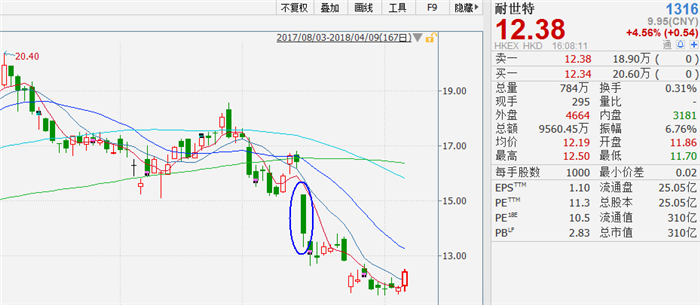
Source: Wind
The same kind of experience happened on sensitive people. On the evening of March 20, 2018, Minxin released 2017 annual results. The company's revenue increased 21.1% year-on-year; gross profit margin decreased slightly by 0.8%; net profit attributable to owners of the company was 20.25 billion yuan, only slightly lower than the market’s earlier forecast of 2.1 billion. .
The next day, the company's share price tumbled 11.06%.

Source: Wind
Although Fuyao and SINBON didn't fall as quickly as they did after the release of their results, the recent stock price performance was far from satisfactory, and they did not have the strong upward momentum of last year.
I think these signs are not related to the market's concern that global car sales will slow down.
First, the growth of the auto market is slowing down, and 2017 to 2018 are all growth years.
In 2017, China's auto sales reached 28.88 million units, ranking first in the world, and winning sales championships for nine consecutive years. The sales trend of the Chinese automobile market has greatly affected the global auto increment.
In the 10 years between 2001 and 2010, China’s auto sales have achieved a compound annual growth rate of 25.3%, and the compound growth rate for 2011-2017 has dropped to 7.7%.
In 2017, new car sales rose by only 1.4% due to demand overdrafts caused by previous years' purchase tax incentives. With the increase in car ownership and the impact of related policies (such as the introduction of purchase tax preferential policies), the momentum of demand growth has weakened, and the market expects that the compound growth rate of car sales will be reduced to around 3% in the next 5 to 10 years.

Judging from the relationship between the industry chain, the parts and components industry is upstream of the entire vehicle industry, and the degree of prosperity is closely related to the sales volume of the entire downstream vehicle. The growth of parts and components revenue lags behind the total vehicle sales for one year.
From 2008 to 2017, the sales growth at the top of the period was 46.1% in 2009, 13.9% in 2013 and 13.7% in 2016, respectively, while the high points of the revenue growth rate of parts and components appeared in 59.6% in 2010, and 17.2% in 2013, respectively. In 2016, it was 25.5%. The growth of the two is highly consistent.
Therefore, with the growth of China's automobile sales in 2017 falling to 3% and expected to further decline this year, the prosperity of the parts and components industry in 2018 will inevitably not be affected.
How will the parts and components industry be affected? We illustrate how they benefit from the faster growth of car sales.
(1) The parts and components companies are heavily operating enterprises. When the sales volume increases rapidly, the capacity utilization rate increases, and the fixed costs and fixed costs allocated to the unit products are reduced. As a result, the company's profit can increase significantly, and vice versa. Of course.
(2) Parts suppliers have stronger bargaining power. As the capacity expansion rate of parts and components companies is generally one and a half to two years, and the speed lags behind the sales volume of the auto market, if the sales volume of the auto market increases rapidly, the production capacity of the parts and components companies will lag behind, and the imbalance between supply and demand will cause a comparison of their bargaining power. Strong.
Therefore, when the growth of car sales has slowed down, the general situation in the auto parts industry will not only face a decline in sales volume, but also the capacity utilization rate and bargaining power will be affected, and the profit margin will fall non-linearly.
In fact, this situation is very similar to mobile phone parts. When the industry is cooled down by high growth and converted into a cyclical property, investors should never touch a company with a very poor business model and can only grasp the structural changes in the industry. Growth opportunities.
The structural transformation of mobile phone parts and components is a further upgrade of the industry, then the future auto parts industry has the following three points.
Second, finding structural opportunities is the key
Structural Opportunity 1: Consumption upgrades lead to structural changes
In the early days, when the car was quickly popularized, everyone's consumption level was insufficient, and consumers were more concerned about product prices. The best example was that at the time, the lower-priced A-class vehicles grew faster, and the configuration of such vehicles was generally lower.
With the increase in car ownership and consumer demand for upgrades, large and medium-sized luxury cars have enjoyed rapid growth. At this stage, consumers are more concerned with high-level configurations such as assisted driving, automatic shifting, smart headlights, keyless start-up, seat heating, and car entertainment.
With the upgrade of car configurations towards higher levels, we can foresee that competition in the future stock market will dilute prices and strengthen the quality experience brought about by configuration upgrades. The growth of high-profile parts and components is still expected.
Some domestic parts and components companies are caught in a dilemma caused by low R&D investment: Corporate R&D investment is small, technology is difficult to upgrade, and thus the added value of products is difficult to increase. The ultimate profitability cannot be improved, which in turn affects the nausea of ​​R&D investment. cycle.
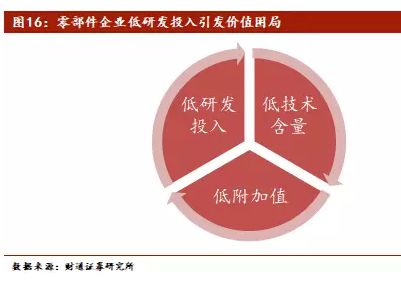
With reference to foreign-invested parts and components suppliers, their research and development expenses rate is generally 5% to 8%. Some companies with strong research and development capabilities and rich core technology reserves, such as Bosch and Delphi (DLPH.US), have R&D expenditure rates as high as 9%.
Structural Opportunity 2: The rise of independent brands brings new opportunities
With the strong rise of self-owned brands in recent years, the pattern of the industrial chain has changed, and a new round of in-depth domestic substitution has been opened, which in turn promotes the rapid growth of the parts and components industry.
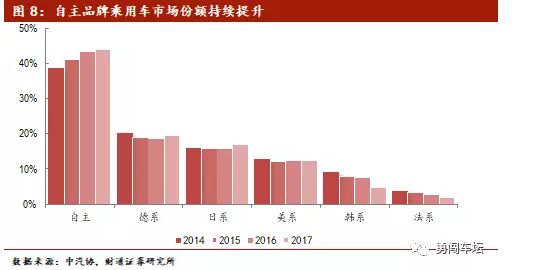
Domestic substitution began in 2005. From the perspective of the import and export data of parts and components, the amount of exports exceeded the import value for the first time in 2005, and the effectiveness of domestic production of parts and components began to appear. At that time, the main form of domestic substitution was a joint venture between a domestic automaker and an international component giant to achieve local production and assembly of parts with low technological content, such as interior and exterior trims.
The latest round of home-made substitutions driven by the rise of self-reliance has significantly increased both in terms of breadth and depth of substitution, and this has further raised higher requirements for parts manufacturers' production capacity and technology.
Structural Opportunity 3: Increased Industrial Concentration
According to data from the National Bureau of Statistics, there were 12,093 suppliers of components above designated size as of 2015. Although a number of professional and relatively large-scale component companies have already emerged in the country, such as Huayu Automobile (600741.SH), Weichai Power (02338.HK) and Fuyao, it will be the domestic first-line and first-line parts of the world. Compared with enterprises, the scale is still small.
The development time of China's spare parts enterprises is relatively short. Basically, they started from parts products with relatively low technological content and margins, relying on one or a few products, and developing one or a few customers, the supporting value of bicycles is relatively low. Market share is scattered.
With the stagnation of the incremental market, large-scale enterprises have obvious advantages in R&D investment, market expansion, and customer service capabilities. It will become even more important in the future to achieve large-scale M&As through acquisitions. Moreover, the auto parts industry has a significant scale effect. Therefore, within the industry through competition, as well as mergers and acquisitions of smaller companies, raising the industry concentration has become a top priority.
National policies are also actively promoting the concentration of auto parts industry. The "Mid-term and Long-term Development Plan for the Automotive Industry" clearly proposes that by 2020, a number of auto parts enterprise groups with a size of more than 100 billion will be formed. By 2025, a number of companies will be formed. The top ten auto parts companies in the world.
Third, multi-dimensional comparison of stocks
Based on the above structural opportunity analysis, overall, the auto parts and accessories industry shares fell more, there are still individual investment opportunities, we will from the following six aspects to Hong Kong stocks auto parts stocks score:
(1) Customer Structure
The higher the degree of customer concentration, means that companies often have a disadvantage in the business negotiations. When the industry is sluggish, the company's profit is more severe.
In addition, sitting high-quality customers can also allow auto parts companies to benefit from the above-mentioned consumer upgrades, because in the context of consumer upgrades, consumers will pay more attention to quality, and sales growth of high-quality models will be guaranteed.
Nexteer:★★
We can see the customer contribution income disclosed by Nexteer. In 2017, GM contributed revenue of 1.667 billion U.S. dollars, accounting for 43% of its total revenue, while the other two accounted for more than 10% of the total customer contribution revenue. The top three customers contributed $2.991 billion in revenue, and revenue accounted for 77.13%.
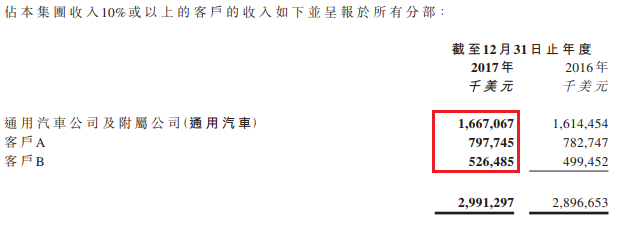
Source: Company Information
Since Nexteer's customer concentration is very high and there is also a single customer dependency on GM, the three customers' business changes have a great impact on the company.
Fuyao Glass: ★★★★★
As the largest automotive glass manufacturer in China, Fuyao Glass's major customers include the world's top 20 automakers and China's top ten passenger vehicle manufacturers. Covers Toyota, Honda, GM, Volkswagen, BMW, Mercedes-Benz, Porsche, Bentley and other car manufacturers.
In 2017, the company’s top five customers accounted for only 16.04% of the company’s revenue, while the Group’s largest customer accounted for 4.78% of revenue. Explain that customers are more dispersed and have stronger anti-risk ability.
Sensitive:★★★★
After more than 20 years of ups and downs, the company has grown from a domestic auto parts supplier to a global supplier with customers all over the world. Its customers include world-renowned OEMs such as: Toyota, Honda, BMW, GM, Ford Benz and others. The company's customers are also relatively dispersed.
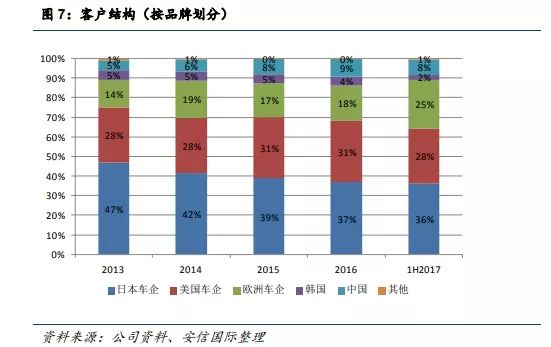
SINBON:★★
More than 70% of the company's revenue comes from major European, American and Japanese automakers, but the top three customers account for about 50% of its revenue, and the risk is relatively high. In addition, the mainstream car manufacturer ABB (Audi, Mercedes-Benz, BMW), the company only Mercedes-Benz customers, in the future of auto consumption upgrade, the vigorous development of the luxury car market, the company's growth may be under pressure.

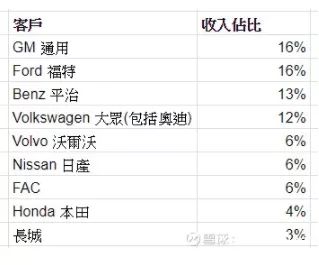
Source: Prospectus
(2) Market share
The short-term slowdown of the industry is often conducive to the improvement of industry concentration. At this time, the advantages of leading players will become more and more obvious.
Nexteer: ★★★★
Nexteer’s core product is an electric power steering (EPS). According to the latest data, Nexteer EPS products have achieved a global market share of 12%, ranking third in the world and first in the United States.
It is predicted that the global EPS penetration rate in 2020 is expected to reach 72%, and the annual global sales volume will reach 77 million units, and the market scale will be as high as 28 billion US dollars. With the further expansion of the company's EPS production capacity, it will form a strong support for performance.
Fuyao Glass: ★★★★★
Fu Yao Group, founded by Cao Dewang, is now China's largest and the world's second largest automotive glass manufacturer. According to the company's response to the SSE E-Interactive platform in early 2017, Fuyao's market share in the domestic market is as high as 60~65%, and its global market share is nearly 20%.
Sensitive:★★★★
Minth is a leader in China's automotive decorative parts, the company's three core business decoration strips, decorative parts, and body structural parts. Its market share in China is about 30%, and its global market share is 9%.
The company has established a solid competitive advantage with its comprehensive customer base, leading globalization, and high productivity resulting from lean management.
Shinbon Holdings: ★★★
Mainly engaged in automotive interior plating parts business, a wide variety of products, including internal handle, door trim, gear change cover, steering wheel parts, control panel components and instrument panel.
In terms of 2016 revenue, the company is the second oldest car plastic electroplating parts market, accounting for about 5% of the market (first 5.2%), but because the market is still relatively dispersed, the moat brought by the market share is not before Several strong.
(3) Comparison of future growth (in-hand orders, capacity expansion)
Nexteer: ★★★
As of December 31, 2017, Nexteer had $23.9 billion (approximately 6 times its 2017 revenue) of orders that had been signed but not yet in production. Newly signed orders generally start production 24 to 30 months after signing. In other words, these huge orders guarantee Nexteer’s performance growth in the next two to three years.
Although the number of orders is alarming, but to know that this figure is lower than the $25.6 billion in 2016, Nexteer’s orders are not satisfactory, which causes investors to judge the company’s low expectations of future revenue growth, but this order The impact was mainly due to the cancellation of some of the orders by the major customers who contributed nearly 40% of the company's orders.
Fuyao Glass: ★★★★
For the expansion of the US second-phase production capacity, 2.5 million sets of production capacity were completed in October last year. Currently in a climbing phase, the overall progress is good. In March this year, it is expected to have 5.5 million sets of capacity. Of these, 15% are for development and 80%-85% for production. In 2018, the U.S. project is bound to become the company's new profit growth point and performance contribution point, and the overall expectation is good.
Sensitive:★★★★★
The Mexican plant is in a ramp-up phase of production in 2018 (the current gross profit margin is about 20%), which will bring new impetus to the growth of the company's performance in the future.
And the company also holds huge orders. As of the end of 2017, the accumulated on-hand orders amounted to RMB 92.2 billion, and the number of new orders received in 2017 reached 5 billion. It is important to know that the earning revenue in 2017 was only RMB 11.38 billion, and the order volume in the hands was more than 8 times of its revenue.
Xinbang:★★★★
The company already has about 9.7 billion yuan of orders in hand, which is 5 times of 2017 total revenue.
The company's new 700,000-square-meter production line in Mexico is planned to be put into use in the first half of 2019. With the addition of a new production line in Jiujiang, Jiangxi, it is expected that by the end of 2019, the company's total production capacity will reach 4.25 million square meters, which is comparable to the capacity at the end of 2017. The increase of 33.6% has laid a good foundation for the company's future expansion.
(4) The biggest challenge of self-development (★ The more representatives are able to overcome difficulties, the lower the degree is)
Nexteer:★★
GM has always been Nexteest’s largest customer (accounting for more than 40% of revenue), and the company’s single customer has a high risk.
In addition, the EPS penetration rate of cars in Europe and the United States has reached 70 to 85%, and future growth can only rely on emerging markets. For example: China, South Asia, South America, and other automotive markets where EPS penetration rate is still very low and local production capacity is seriously insufficient. For example, China's HPS accounted for about 63% of sales of new cars, EPS accounted for about 35%, and the EPS carrying rate of self-owned brand cars is only 20%.
If new-model car sales do not reach expectations, company growth will be severely challenged.
Fuyao Glass: ★★★★★
The new US production capacity may not climb as expected, but so far, the progress of US factories has been satisfactory, so the actual risk is among the lowest among several accessories suppliers.
Sensitive:★★★★
The increase in the utilization rate of the second plant in Mexico in 2018 may be due to a number of factors that lead to a lower utilization rate and yield than the company average.
Last year, 20% of the company's revenue contribution came from North America. Trump's export tariff policy adjustment has a negative impact on sensitivity.
Xinbang:★★
The company does not have the experience of establishing a factory in Mexico. Therefore, the gross profit rate and yield of Mexican factories are likely to be less than expected. Last year, 26% of the company's revenue contribution came from North America. Trump's export tariff adjustments have a negative impact on sensitivity.
(5) Financial comparison

Source: Annual Report
From the above figures of the company's 2017 annual reports, we find that SINBON has the highest level of profitability and the lowest level of liabilities, and the highest score is due. While Nexteer’s profitability is the weakest, and the highest level of debt, the lowest score is more reasonable.
(6) R&D investment
From the perspective of R&D investment, the R&D input of the four companies is about 2% to 4% of revenue, which is not as good as 5%~8% of foreign-invested parts suppliers. Among them, SINBON is only 2.3%.

Fourth, summary

In general, the growth of the automotive industry has slowed down. With only structural investment opportunities, Fuyao and Minmin have the highest overall score and are the safest bottoming varieties.
chrome yellow has high bright yellow pigment, and high hiding powder, well tinting strength, heat-resistance,etc advantages, non-toxic, etc.
Usage:
1. Used in kinds of paints, including water-soluble paint for outside and inside wall, and oil paint including kinds of first coat and face coat such as epoxy, alkyd, amine etc.
2. Used in coloration for construction materials, i.e. mosaic brick, levigation level ground, concrete production, brick for pavement, colorful tiles and man-made marble, etc.
3. Used in coloration for colorful paper.
4. Used in surface coloration for rubber production, and strengthen the abrasion resistance of rubber filling.
5. Used in coloration for plastics, which is harder to fade.
6. Used in detecting the damage degree of machine by its magnetism.
Chrome Yellow,Chrome Yellow Pigment,Chrome Yellow Color,Middle Chrome Yellow
Yucheng Jinhe Industrial Co.,Ltd , https://www.jinhetec.com